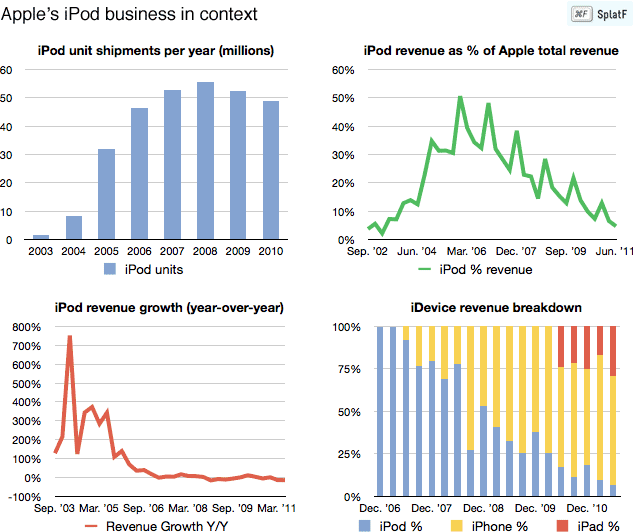What should Apple do with the iPod?
Apple’s iPod turns 10 years old next month. Steve Jobs first introduced it on Oct. 23, 2001, and it went on sale a few weeks later. After a fairly slow start, the iPod eventually became Apple’s main growth driver, helped lead the company’s amazing comeback, and then gave way to the iPhone and iPad. (See charts.)
Today, the iPod business is in decline, while the rest of Apple continues to grow rapidly — especially the iPhone and iPad. So as Apple CEO Tim Cook looks ahead at the company’s product roadmap, what should he do with the iPod?

It’s easy to say that the right move is to shut down the iPod line and focus on the iPhone, iPad, Mac, and Apple’s opportunity in the TV business. Especially as Apple already seems to be winding down the “iPod” brand within iOS, splitting the iPod app into separate “Music” and “Video” apps. But in reality, it’s not that simple.
- The iPod touch, for example, is a meaningful member of the iOS family. It represents more than half of iPod shipments, drives huge download numbers for iOS games, and is a great device for kids, foreign tourists, and BlackBerry owners.
- The iPod nano is small and cheap ($149), and the iPod shuffle is smaller and $100 cheaper. Both make solid gifts or running accessories, and Apple will sell millions of them this holiday season. Both offer an inexpensive entry point to the Apple story, which could lead to future iPhone, iPad, and Mac sales. (The “iPod halo effect.”)
- The iPod classic is still the only way to get a 100+ GB iTunes library into your pocket, and the 160 GB model is Amazon’s no. 3 best-selling iPod, after two iPod touch models. (And Amazon’s no. 18 best-selling electronic gadget overall.)
- While the iPod line doesn’t contribute as much revenue as it used to, especially relative to the rest of Apple’s business, it’s probably bringing the company’s profit margins up, and not down.
Eventually, of course, something will have to change. And it may even start this year.
Just speculating, but I could see the iPod touch eventually getting a 128 GB option, allowing Apple to retire the iPod classic. (If that’s even necessary in a post-iCloud era.) I could also see the iPod shuffle going away, so that only touchscreen-based iPods remain. (Although Tim Cook defended the shuffle on Apple’s last earnings call, noting that it’s a product that Apple is “very proud of” that “a lot of people love.”)
And I could see Apple splitting the iPod touch into two devices: A “nano” or “mini” that runs some sort of iOS apps, and a full-sized version with an even bigger screen, ideal for gaming and video.
- The iPod nano could be the $100 thing you give your kids, wear as a watch, use as an Apple TV remote, and buy your boss for his birthday. It could come in a zillion colors.
- The new “regular” iPod touch could sport a ~4.5-inch screen, and might even come with optional 3G wireless data service, like the iPad does. This could be a gaming monster (with the same screen resolution as the iPhone).
This would allow Apple to keep the iPhone smaller and more pocket-friendly — who really wants to carry around a 4.5-inch screen all day? — while differentiating the iPod touch a little. It could potentially give people a reason to own both, or at least consider it. In fact, I wonder if the rumored iPhone 5 with a bigger screen and teardrop shape isn’t actually the new iPod touch.
Change will inevitably come to the iPod business as it continues to shrink. But it still represents more than 40 million shipments a year to Apple and billions in revenue. The iPod touch is an important product as it supports the iOS app and iTunes content ecosystems.
My hunch is that beginning within a few years, Apple will start simplifying the iPod business, focusing it around the iPod touch, and either letting it stand on its own or folding it into the iPhone or iPad lineups. But it’s probably not just going to disappear anytime soon.
Also: How Apple can fix iAd

Check out my new site: The New Consumer, a publication about how and why people spend their time and money.

